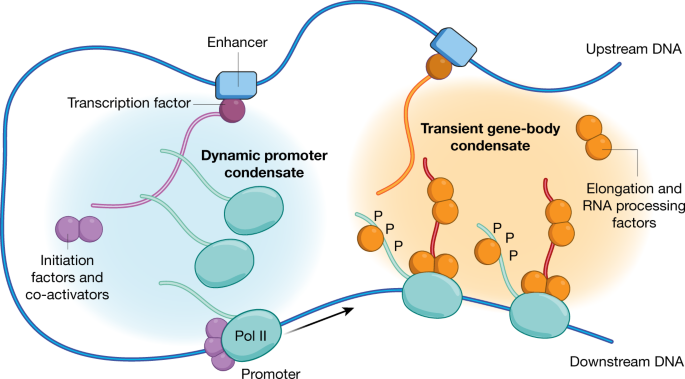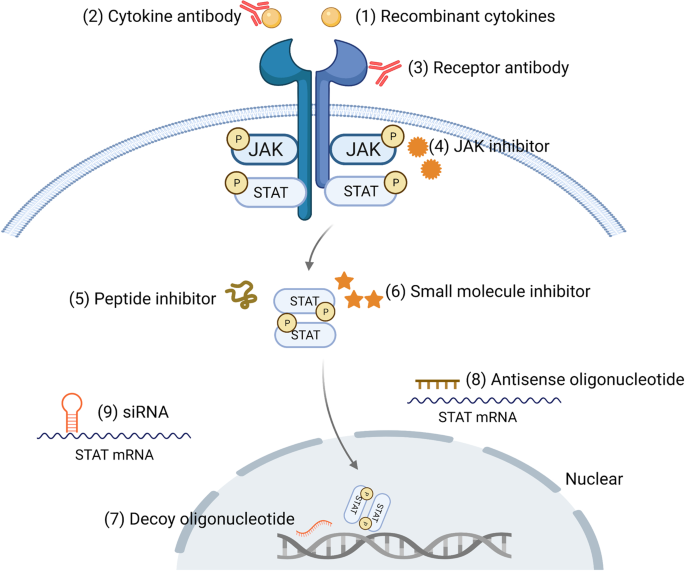Core Concepts
This article discusses transcriptional regulation, its mechanisms, and the cellular pathways commonly influenced by transcriptional regulation.
Topics Covered in Other Articles
Introduction to Transcriptional Regulation
Transcriptional regulation is a biological process by which cells control the central dogma, or the conversion of DNA to RNA, and RNA to proteins. Transcriptional regulation is how cells determine which genes are expressed at any given time. This ensures that genes are turned on or off as needed, allowing cells to respond to signaling, differentiate, and maintain homeostasis. In the body, transcriptional regulation is essential for processes such as development, immune response, and adaptation to environmental changes. Recent scientific developments in the field of transcriptional regulation include the development of targeted therapies for diseases. In these cases, gene expression patterns are disrupted in order to control or entirely prevent diseases like cancer from occurring. Further, these studies provide advancements in regenerative medicine, where controlled gene expression can guide stem cell differentiation and tissue regeneration.
Mechanism of Transcriptional Regulation
Transcriptional regulation plays a crucial role in the proper functioning of organisms by ensuring that genes are expressed at the right time, in the right cells, and in appropriate amounts. The mechanisms of transcriptional regulation involve a series of coordinated steps. First, transcription factors, which are proteins that bind to specific DNA sequences, recognize and attach to promoter regions near the genes they regulate. Transcription factors can either activate or repress the transcription of the gene. Binding to promoter regions often induces a conformational change in the DNA and the transcription factors themselves. In the case of activation, these conformational changes make the DNA more accessible, allowing essential proteins to bind more easily. Conversely, inhibition involves conformational changes that compact the chromatin (protein complexes that organize the genetic material within cells), making the DNA less accessible.

Some genes are always inhibited or activated until specific signals prompt a change in their transcriptional status. These genes are regulated by transcription factors that continuously repress or activate their transcription. This dynamic regulation allows cells to rapidly respond to changing environmental conditions and developmental cues.

Next, coactivators or corepressors are recruited to interact with transcription factors, enhancing or inhibiting DNA access. The chromatin structure may then undergo modifications, such as histone acetylation or methylation, changing the DNA’s accessibility. Once the chromatin is modified, RNA polymerase is recruited to the promoter region to initiate mRNA transcription. The transcription process then proceeds through elongation, where RNA polymerase synthesizes the mRNA strand. Finally, transcription ends with termination, releasing and processing the mRNA for protein translation.
Cell Differentiation
One cellular mechanism driven by transcriptional regulation is cell differentiation in which a stem cell is developed into a specialized cell type. This process is initiated by signaling molecules from the cell’s environment or other cells triggering intracellular signaling pathways. This leads to the activation of specific transcription factors including the following:
- Octamer-binding transcription factor 4 (Oct4): essential for maintaining the pluripotency of embryonic stem cells
- SRY-box transcription factor 2 (Sox2): works alongside Oct4 as well as crucial for neural differentiation
- Myogenic Differentiation 1 (MyoD): regulator of muscle cell differentiation
- GATA1: involved in hematopoietic differentiation, particularly in the development of red blood cells and megakaryocytes
Once transcription factors and cofactors or repressors modify chromatin structure, the newly transcribed mRNA is translated into proteins. These proteins drive the cell’s structural and functional characteristics. Concurrently, genes that are not needed for the specialized cell type are repressed, ensuring only the appropriate genes are expressed. Through this process, a stem cell progressively acquires the specific attributes of its differentiated state. This enables the diverse functions necessary for complex organisms.
Response to Cell and Environmental Signaling
A cell’s ability to respond to signaling from other cells as well as its surrounding environment is a critical process that is both influenced by and influences transcriptional regulation and its mechanisms. When a cell receives external signals, such as growth factors, hormones, or stress signals, these signals are transmitted through cell surface receptors. This triggers intracellular signaling cascades. Signal cascades involve series of phosphorylation events where kinases activate down stream proteins, amplifying the initial signal. This amplification allows a small extracellular signal to produce a significant cellular response. Key pathways involved include the MAPK/ERK pathway, the JAK/STAT pathway, and the PI3K/AKT pathway. These pathways activate or inhibit specific transcription factors by phosphorylating them or altering their location within the cell. Ultimately, these cascades lead to changes in gene expression that enable to cell adapt to its environment, proliferate, differentiate, or respond to stress.

For instance, in the MAPK/ERK pathway, activated ERK translocates to the nucleus, where it phosphorylates transcription factors such as Elk-1, leading to the expression of genes involved in cell growth and differentiation. Similarly, the JAK/STAT pathway involves STAT proteins that, once phosphorylated, dimerize and move to the nucleus to initiate transcription of target genes. These pathways ensure that transcriptional responses are tightly regulated in response to changing environmental conditions, allowing the cell to adapt, proliferate, or differentiate appropriately. By integrating external signals with gene expression, cell signaling pathways play a vital role in maintaining cellular function and responding to physiological demands.
